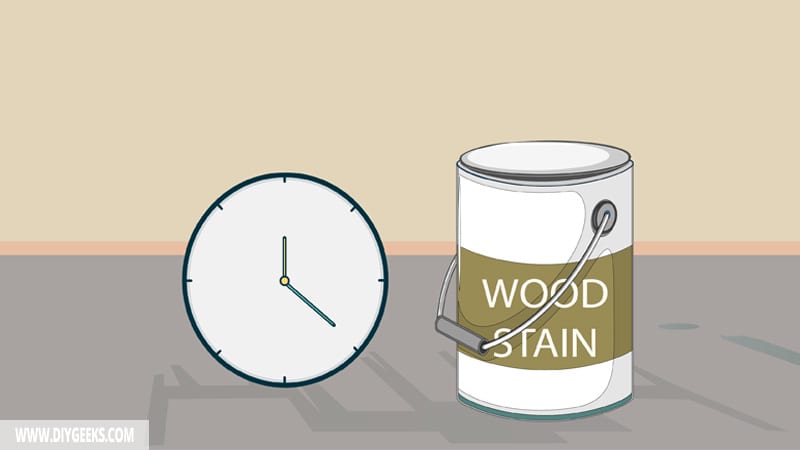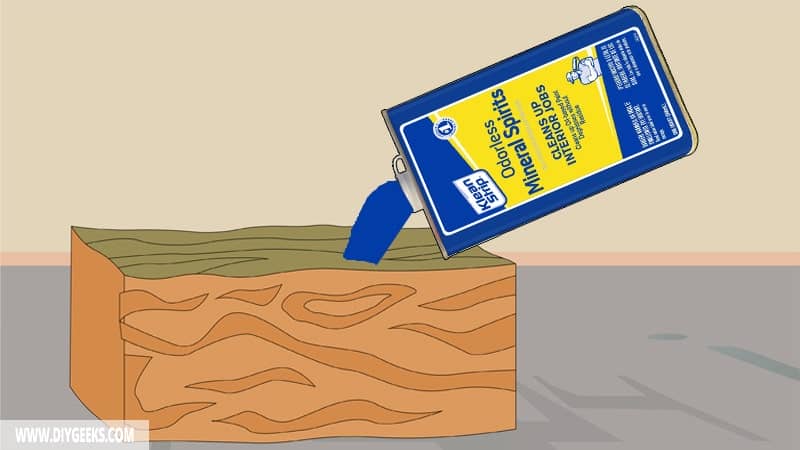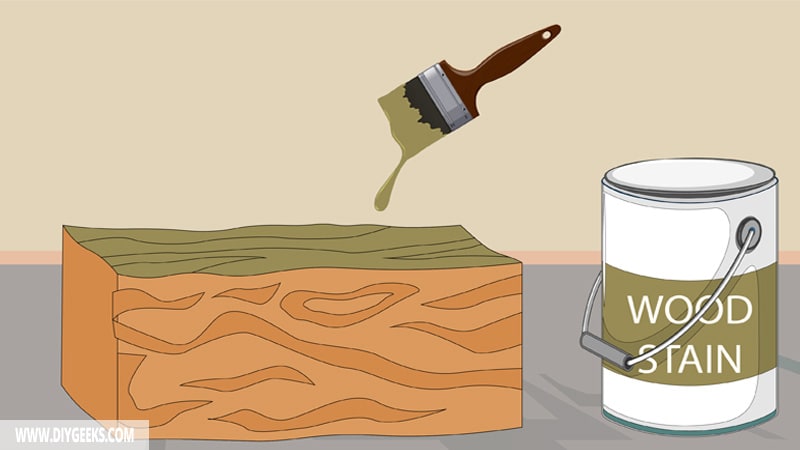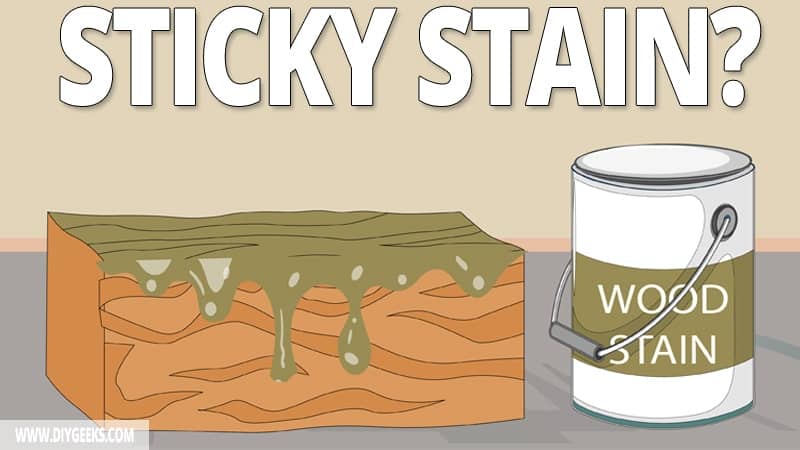Wood stain is a type of finish that enhances wood’s appearance by altering the color and highlighting the natural grain of the wood.
To fix sticky wood stain, use mineral spirits or apply more wood stain coats over the finish.
Mineral spirits will dissolve the coating making it easier to wipe off the excess. More wood stain coats will add more solvent (oil or water) to the surface, making the finish easier to wipe off.
Once you wipe off most of the wood stain, the remaining will dry easier and the finish won’t be sticky anymore.
If the finish remains sticky even after you remove most of the wood stain, there’s something wrong with the surface. In that case, remove the entire finish, inspect and fix the surface, and re-apply the wood stain.
Why Does Wood Stain Turn Sticky?
Wood stain turns sticky for the following reasons.
- The excess wasn’t wiped off.
- High Humidity.
- You Re-coated Too Soon.
1. The Excess Wasn’t Wiped Off
The main reason a finish turns sticky is that there’s too much of it on the surface and the solvent can’t evaporate. This is why you should always remove the excess 30 minutes after applying it.
Wood stain by design doesn’t sit on wood, instead, it penetrates the grain. So, if you apply too much of it, the excess will not penetrate the grain, instead, it will stay on the top layer. Since the stain isn’t designed to sit on the wood, it won’t dry properly regardless of how long you wait.
So, if you apply wood stain, always ensure to wipe off the excess 30 minutes after applying it.
2. There’s High Humidity
The wood stain should be applied in a room or environment where the humidity is not more than 50%. If the humidity levels are higher than 50, the coating won’t dry because the solvent can’t evaporate. The high moisture content in the atmosphere will settle on the coating as it starts to dry making it wet.
The coating will eventually dry, but it will take 2 times more than usual.
3. You Re-Coated Too Soon
The finish will turn tacky if you re-coat too soon. That’s because the existing coating is still wet (the solvent hasn’t evaporated yet), so if you apply a new coating over it too soon, the solvent will be stuck between two layers and prevent the finish from drying.
Does Sticky Wood Stain Dry Itself?

Some sticky wood stain finishes dry itself, while some won’t. The finish will dry itself if it’s sticky because you re-coated too soon. Once the coating is exposed to increased heat, the solvent between the two coats will evaporate and the finish will dry.
The finish won’t dry itself if there’s something wrong with the surface. If the surface is wet or something is preventing the penetration (e.g. blocked pores), the finish will remain wet. This happens when the finish turns sticky after drying.
If a surface is wet, it means the wood pores are already filled with water, so the stain won’t be able to penetrate it. In this case, the coating stays over the top layer of wood and remains wet. To fix this, you must remove the entire finish, fix the issue (dry the surface), and re-apply it.
How To Fix Sticky Wood Stain?
To fix sticky wood stain, do the following things.
- Use Mineral Spirits.
- Apply More Wood Stain.
1. Use Mineral Spirits

You must remove excess wood stain from the surface so the remaining can dry if there’s too much of it. To do so, use mineral spirits or paint thinner.
The mineral spirits (or paint thinner) will dissolve the excess or turn it into liquid. Once the excess stain turns liquid, wipe it off the surface. The remaining (that wasn’t removed or liquefied) will dry itself.
The tools you need for this method are listed below.
- A paint thinner (preferably mineral spirits)
- A pair of gloves
- Clean rags
- An angled paintbrush.
To use mineral spirits over a sticky wood stain, do the following.
- Apply the Mineral Spirits. Damp a rag with mineral spirits and use the dampened rag to wipe the surface repeatable. You won’t need to douse the surface with mineral spirits, just apply enough to dissolve the coating.
- Wait 10 minutes.
- Wipe The Excess. Once the coating liquefies, use a clean rag to remove (wipe off) the excess. After you wipe it off, the remaining will stay on the surface and dry properly.
2. Apply More Wood Stain

Adding more wood stain to the surface will just add more solvent (water or oil) over the existing coatings. This makes the coating liquefy, making it easier to wipe off the excess.
However, you should only apply the same type of wood stain (oil or water-based) as the existing one.
The tools you need for this method are listed below.
- A paintbrush
- The same wood stain that was applied
- Clean rags
- Wood stain thinner (optional)
Here is how to use this method:
- Thin Wood Stain (Optional). Do this only if you thinned the first stain coating that you applied.
- Apply The Wood Stain. Apply wood stain over the existing coating, and wait 5 minutes. The new coating will add more solvent to the existing stain and liquefy it.
- Wipe Off The Excess. Once the coating starts to liquefy, wipe off the excess.
- Leave The Remaining To Dry. The stain that has penetrated the wood pores should be left to dry naturally. Once it dries, you can add one or two more coats.
How To Prevent Sticky Wood Stain?
To prevent sticky wood stain, do the following things.
- Allow Enough Dry Time.
- Wipe the Excess.
- Mix it Properly.
1. Allow Enough Dry Time
The wood stain finish won’t dry properly if you don’t allow enough dry time between coats.
If you re-coat soon, the solvent won’t evaporate and the coating will remain wet. The remaining solvent (or moisture) will later bleed through the coatings, making it wet.
The finish will appear blotted and have different color patches. To avoid this, ensure to leave enough dry time between coats.
2. Wipe The Excess
Wipe the excess wood stain 30 minutes after applying it. Within 30 minutes, the needed wood stain will penetrate the surface pores, the remaining coating isn’t needed and you must wipe it off.
The remaining coating is what makes the finish sticky. That’s why you must always wipe off the excess.
3. Mix It Properly
Mix (shake) the wood stain properly before applying it. The pigments of the finish are at the bottom of the container, so mixing (or shaking) it will help you achieve an even and colorful finish.
FAQ’s
How Long Can Wood Stain Remain Tacky?
Wood stain finish can remain tacky for weeks if you don’t wipe off the excess (or fix the issue). The needed wood stain will penetrate the wood and leave the unnecessary (extra) stain on top of the wood surface, if you don’t remove it it will stay there for weeks.
Which Wood Stain Types Won’t Turn Sticky?
All penetrating wood stains will turn sticky if you don’t wipe them out. However, if you apply thin coats you will get a darker color that won’t turn sticky. The trick here is to add very thin layers.
You can also use topical finishes, such as gel stains. Gel stain doesn’t penetrate a surface to stick — instead, it stays on top of the layer until it dries, therefore it won’t turn sticky.
[sc name=”stickywoodstain”][/sc]


